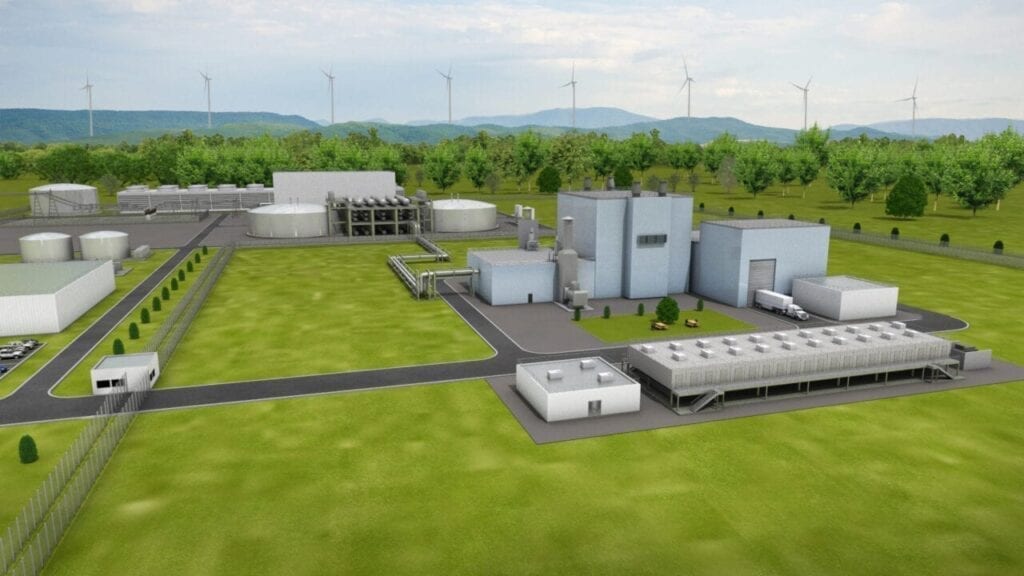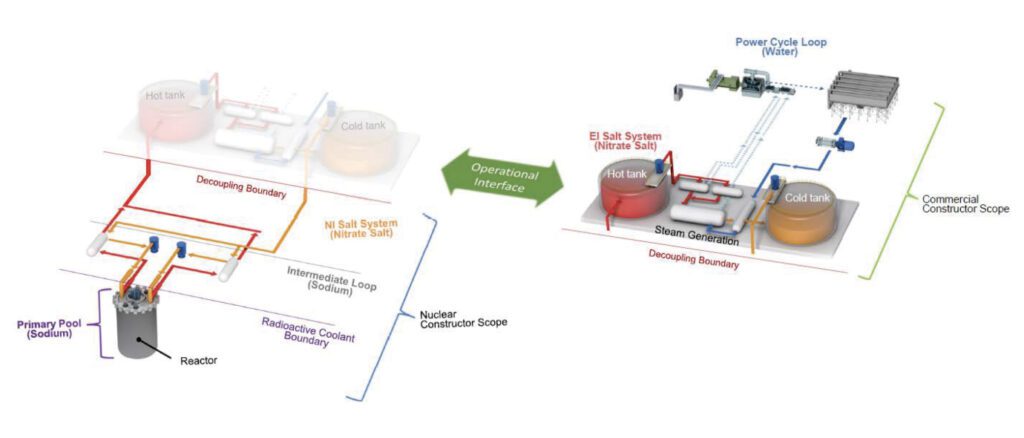Bill Gates’ nuclear innovation firm TerraPower has broken ground on the non-nuclear portion of Kemmerer Unit 1, a 345-MW Natrium sodium-cooled fast reactor (SFR) power plant. The groundbreaking on June 10 makes the federal demonstration project the first advanced nuclear reactor project to move from design into construction in the Western Hemisphere, the company noted.
The project is taking shape in Lincoln County, Wyoming, about 3 miles from PacifiCorp’s three-unit 604-MW coal and gas–fired Naughton Power Plant, furnished with up to $2 billion in authorized funding under the Department of Energy’s (DOE’s) Advanced Reactor Demonstration Program (ARDP).
Bellevue, Washington, headquartered TerraPower submitted a construction permit application (CPA) to the U.S. Nuclear Regulatory Commission (NRC) in March 2024 (through a wholly owned subsidiary US SFR Owner, and the NRC accepted the CPA on May 21. While the NRC is now working on establishing a review schedule for the CPA, TerraPower says it anticipates submitting the operating license in 2027, allowing it to begin construction on the nuclear island in 2026 and complete the plant “this decade.”
Upon completion, the Natrium demonstration plant will be a fully functioning commercial power plant that will showcase the pioneering technology and provide power capacity in the PacifiCorp service area. TerraPower also underscored that the project is currently “the only coal-to-nuclear project under development in the world.”

A Pioneering Nuclear-Storage Hybrid
Kemmerer 1 will be a hybrid nuclear facility integrating an 840 MWth pool-type Natrium SFR reactor with a nitrate molten salt-based energy storage system. The plant’s energy storage has the potential to boost the system’s output to between 100 MWe and 500 MWe of power for more than 5.5 hours when needed, ramping at 10% a minute, the firm says.
The plant mainly comprises a nuclear island (NI), housing the reactor (in a compact and simple safety envelope) along with its core and primary heat transport systems, and the energy island (EI), containing the thermal energy storage tanks, steam generator, feedwater system, condenser, turbine, and supporting systems. The islands are designed to function independently with minimal interdependencies, connected only by the nuclear island salt system.

At the start of the process, the reactor uses sodium-bonded metallic fuel with high chromium martensitic steel (HT9) cladding to sustain a nuclear chain reaction. The reactor operates by circulating sodium coolant through its core, where it absorbs the heat generated by nuclear fission in the fuel assemblies. This thermal energy is then transferred via in-vessel pumps and heat exchangers within the Primary Heat Transport (PHT) system to an Intermediate Heat Transport (IHT) system. According to TerraPower, the reactor’s heat output is greater than 500C (930F).
Compared to a traditional sodium fast reactor (which generates steam through a sodium-to-water steam generator), Natrium removes the sodium water reaction entirely, as Mark Werner, TerraPower vice president of plant delivery, told the NRC on May 15. “We do have an air cooling system that removes heat directly from the outside of the reactor, and this allows us, effectively, indefinite passive emergency decay heat removal in the case of a severe abnormal event,” he said. “Since our reactor is a pool-style sodium reactor, we do not operate at a high coolant pressure, we’re a very low coolant pressure, near atmospheric pressure.”
During normal operations, the IHT directs the reactor’s generated heat to the Nuclear Island Salt System (NSS) for energy storage or use. During startup and shutdown, heat is dissipated into the atmosphere through the Intermediate Air Cooling System (IAC). (The process continues as the heated sodium from the core mixes in the reactor’s hot pool and then circulates through intermediate heat exchangers before being recirculated back to the core.)
Secondary systems then transform this generated heat into electrical power. The heat from the IHT is transferred to the nuclear island salt system (NSS) via sodium-salt heat exchangers, moving through the Salt Heat Transport System to the Thermal Salt Storage System (TSS). The salt stored in the TSS hot tank is pumped through the steam generators and sent to the TSS cold tank. The steam generator equipment converts water into steam by passing the hot salt through an economizer (water preheater), evaporator, superheater, and reheater, providing steam to the turbine to produce power.
“The entire size of the nuclear island is approximately 16 acres. The overall site area is approximately 44 acres. When normalized to power rating, the Natrium system has a smaller footprint compared to other Generation IV reactors,” TerraPower notes.
Another Step Forward for the ARDP
As POWER reported, in 2020, the DOE selected TerraPower and X-energy as the initial awardees of its ARDP, suggesting that the two projects effectively fulfilled its criteria and were most capable of developing unique advanced nuclear reactors and initiate their operation by 2028.
The ARDP’s tight seven-year timeframe spurred rapid development by the two companies. TerraPower picked the Wyoming site in 2021 for its Natrium demonstration. While X-energy’s project was originally slated to be developed with Energy Northwest in Washington state, the company announced in May 2023 that it would move its Xe-100 pebble-bed high-temperature gas reactor demonstration to a Dow site in Seadrift, Calhoun County, Texas.
Both developers are however fielding challenges related to their first-of-a-kind projects. Each is working to meet a long list of pioneering milestones as they relate to research, plant design, equipment testing and qualification, and procurement and construction.
X-energy suggests it is preparing a construction permit application, anticipating that plant construction will begin in 2026. TerraPower is meanwhile now eyeing a 2030 start date, citing a lack of high-assay, low-enriched uranium (HALEU) availability. In July 2023, the company announced a memorandum of understanding with Centrus Energy to “significantly expand their collaboration” to ensure the demonstration reactor will have access to HALEU to meet the 2030 schedule. And, as POWER recently reported, the company has taken more steps to bolster a domestic nuclear fuel supply chain.
TerraPower has also taken steps to cement its suppliers. It says it is planning for Bechtel Corp. to build the reactor “with the help of many direct employees and subcontractors.” In February, it awarded contracts to GERB for Kemmerer 1’s seismic isolation equipment, Thermal Engineering International for sodium-salt heat exchangers, Hayward Tyler for sodium pumps, Framatome for fuel handling machines, and Teledyne Brown Engineering for the In-Vessel Transfer Machine.
On Monday, the company indicated it has also pinned down estimates of the workforce it will need to build and operate Kemmerer 1. “Approximately 1,600 workers will be needed for construction at the project’s peak,” it said. “Construction is set to span five years. Once the plant is operational, the company estimates that 250 people will support day-to-day activities, including plant security.”
Much more work remains, but key stakeholders remain optimistic about the project. According to Craig Albert, Bechtel president and chief operating officer, the project is already uniquely well-planned. “TerraPower extended their visionary approach to the building of the plant itself. Their involvement of Bechtel from the very beginning means the entire project lifecycle, including construction, has been optimized at every stage, making the entire process cost-effective, fast, and repeatable,” he said on Monday.
In addition, Albert suggested the project will benefit from standardized digitalization efforts. “Natrium will be the first nuclear project where the execution of those plans will benefit from Bechtel’s suite of digital tools and systems, which have been proven to deliver exceptional results on other large energy facilities,” he noted.
Commentary following TerraPower’s announcement has meanwhile highlighted the project’s potential impact on the future of the nascent advanced nuclear industry. Public and private efforts are ramping up to address longstanding risks hindering new nuclear, including high costs, cost overruns, and delays. At the end of May, the White House convened a nuclear management and delivery group to ensure the delivery of the nation’s future fleet will be efficient and cost-effective.
“While these first-of-a-kind projects can be big and risky, they are too important for our future to fail to act,” wrote Bill Gates in a recent blog post. “I’m proud of all those who have helped ensure the most advanced nuclear project in the world gets built right here in the U.S.” Gates noted “TerraPower’s sophisticated work has drawn interest from around the globe, including an agreement to collaborate on nuclear power technology in Japan and investments from the South Korean conglomerate SK and the multinational steel company ArcelorMittal.”
Chris Levesque, TerraPower president and CEO agreed. “This groundbreaking represents the beginning of the next era of nuclear energy,” he said. “The Natrium reactor is more than a design, it’s a plant coming to life that will support both the clean energy transition and our historic energy communities.”
—Sonal Patel is a POWER senior editor (@sonalcpatel, @POWERmagazine).
- SEO Powered Content & PR Distribution. Get Amplified Today.
- PlatoData.Network Vertical Generative Ai. Empower Yourself. Access Here.
- PlatoAiStream. Web3 Intelligence. Knowledge Amplified. Access Here.
- PlatoESG. Carbon, CleanTech, Energy, Environment, Solar, Waste Management. Access Here.
- PlatoHealth. Biotech and Clinical Trials Intelligence. Access Here.
- Source: https://www.powermag.com/kemmerer-1-breaks-ground-a-look-at-terrapowers-natrium-fast-reactor-nuclear-power-plant/
